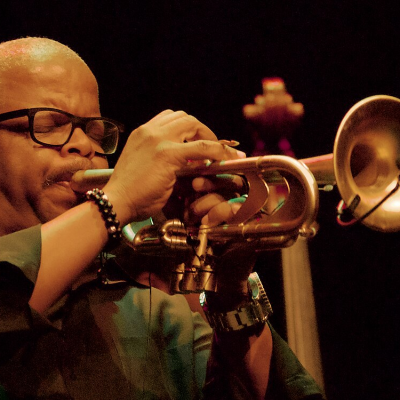An Online Story of Jazz in New Orleans
With an introduction by Nat Hentoff
__________
Featuring the complete text of chapters 1 – 5 from Hear Me Talkin’ To Ya: The Story of Jazz As Told By the Men Who Made It, a 1955 book by Nat Shapiro and Nat Hentoff
(Published with the consent of Nat Hentoff)
Chapter
*
Chapter 1
It was always a musical town – especially The District – Storyville
_____________
Among those featured in Chapter 1:
|
Louis Armstrong |
Jelly Roll Morton |
Bunk Johnson |
_____________
|
Storyville * Canal Street Blues , by King Oliver’s Creole Jazz Band |
DANNY BARKER
One of my pleasantest memories as a kid growing up in New Orleans was how
a bunch of us kids, playing, would suddenly hear sounds. It was like a
phenomenon, like the Aurora Borealis – maybe. The sounds of men playing
would be so clear, but we wouldn’t be sure where they were coming from. So
we’d start trotting, start running – “It’s this way!” “It’s that
way!” – And, sometimes, after running for a while, you’d find you’d
be nowhere near that music. But that music could come on you any time like
that. The city was full of the sounds of music…
CLARENCE WILLIAMS
Yes, New Orleans was always a musical town – a happy town. Why, on Mardi
Gras and Christmas all the houses were open and there were dances all over.
It was “open house” everywhere, and you could walk in almost any door and
have a drink and eat and join the party.
|
photo by John N. Teunisson
Canal and Rampart Streets _____ King Porter Stomp , by Jelly Roll Morton |
|
DANNY BARKER
There were countless places of enjoyment that employed musicians, not including
The colored and white bands battled (or bucked), frequently
The city was split by Canal Street, with one part of
But the people I knew called all that was in Storyville |
photo George Francois Mugnier
Live oak, Audubon Park
|
|
© Estate of E. J. Bellocq/Lee Friedlander
Storyville prostitute, 1912 _____ New Orleans Stomp , by King Oliver’s Creole Jazz Band |
LOUIS ARMSTRONG
There was so much good music that was played in Storyville — they talked
Storyville was kind of divided – I’d say –
|
| ALPHONSE PICOU
Those were happy days, man, happy days. Buy a keg of beer for one dollar DANNY BARKER
New Orleans, until the ‘twenties, was the safest haven in the Americas for
Most arrests were Negroes who frequented barrooms and
As for the big sporting houses in The District, they |
Cornelius Durkee Photograph
St. Ann and Chartres Streets, 1901 _____ New Orleans was a Free and Easy Place, comments by Jelly Roll Morton |
|
The townhouse brothels of Storyville _____ The Stomping Grounds, comments by Jelly Roll Morton
Sobbin’ |
JELLY ROLL MORTON
So, in the year of 1902, when I was about seventeen years old, I happened
The Tenderloin District in New Orleans was considered
Every place in New Orleans had a gambling house, and
I’m telling you this Tenderloin District was like something
The streets were crowded with men. Police were always
Some very happy, some very sad, some with the desire
They had everything in The District from the highest |
| SPENCER WILLIAMS
All along this street of pleasure there were the dance halls, honky-tonks, BUNK JOHNSON
That was the Crescent City in them days, full of bars, honky-tonks, and barrel
I knew Mamie Desdoumes real well. Played many a concert
When Hattie Rogers or Lulu White would put it out that |
Tony Jackson _____ Jelly Roll Morton talks about Tony Jackson, part one
Pretty Baby , written by Tony Jackson and performed by Jelly Roll |
LOUIS ARMSTRONG
Lulu White was a famous woman of the sporting world in Storyville. . .She
had a big house on Basin Street called Mahogany Hall. . .The song was written
after her house had gotten so famous. . .Rich men came there from all parts
of the world to dig those beautiful Creole prostitutes. . .And pay big money.
. .Lulu White was colored. . .Around the corner from Lulu White was the famous
Cabaret of Tom Anderson. . .All the race-horse men went there during their
stay and the racing season in New Orleans. . .In those days a band who played
for those places didn’t need to worry about salaries. . .Their tips were
so great until they did not even have to touch their nightly gappings. .
.Most of the places paid off the musicians every night after the job was
over instead of the weekly deal. . .That was because those places were threatened
to be closed any minute. So the musicians and the performers didn’t take
any chances.
|
The parlor of Lulu White’s Mahogany Hall _____ Tiger Rag , by Jelly Roll Morton |
|
MAHOGANY HALL “SOUVENIR” BOOKLET The NEW Mahogany Hall
A picture of which appears on the cover of this souvenir was erected
The elevator, which was built for two, is of the latest style. The entire The shot upstairs, The shot downstairs, And the shot in the room. . .
This famous West Indian octoroon first saw the light of day thirty-one years
In describing Miss Lulu, as she is most familiarly called, it would not be
Her establishment, which is situated in the central part of the city, is
She has made a feature of boarding none but the fairest of girls – those
As an entertainer Miss Lulu stands foremost, having made a life-long study ADVERTISEMENT NEW ORLEANS BLUE BOOK
COUNTESS WILLIE PIAZZA
Is one place in the Tenderloin District you can’t very well afford to miss.
If there is anything new in the singing and dancing line that you would like
The Countess wishes it to be known that while her mansion is peerless in “Just ask for Willie Piazza.” PHONE 4832 MAIN 317 N. Basin |
|
© Estate of E. J. Bellocq/Lee Friedlander
|
© Estate of E. J. Bellocq/Lee Friedlander
|
DANNY BARKER
There were all kinds of characters and all kinds of places in The District.
I’ve been keeping a scrapbook, based on what I remember and on what other
musicians have told me. Here are some of the things from my book:
Definitions of Different Types of
Joints
Whore house – managed by a
larceny-hearted landlady, strictly business
Brothel – juice joint with rooms,
and a bunk or a cot near.
Sporting house – lots of stimulants,
women, music. An old queer or cripple serves
Crib – Two or three stars venture
for themselves, future landladies.
House of assignation – women pull
shifts and report where they are needed.
Clip joint – While one jives you,
another creeps or crawls in and rifles your pockets.
And here are some sporting women and the nicknames of a few well-known Crescent
City characters:
Albertine McKay, former sweetheart of Lee Collins. She marched him around
with a .38 special loaded with dum-dum bullets.
Daisy Parker, Louis Armstrong’s moll, who greeted him with a brickbat.
Kidneyfoot Rella, who is said to have spit in Black Benny’s face as he lay
dead in his coffin.
Also — Flamin’ Mamie, Crying Emma, Bucktown Bessie, Dirty Dog, Stell Arm
Johnny, Mary Meathouse, Gold Tooth Gussie, Big Butt Annie, Naked Mouf Mattie,
Bird Leg Nora, Bang Zang, Boxcar Shorty, Sneaky Pete, Titanic, Coke Eye Laura,
Yellow Gal, Black Sis, Boar Hog, Yard Dog, Bodidily, Roody Doody, Big Bull
Cora, Piggy, Big Piggy, Stingaree, Bull Frog Sonny, Toot Nan, Knock on the
Wall, Sore Dick, Sugar Pie, Cherry Red, Buck Tooth Rena, Bad Blood, Copper
Wire, Snaggle Mouf Mary, Linker-Top, Topsy, Scratch, Joe the Pimp, Onery
Bob, Tee Tee, Tee Nome, Tee Share, Tee Boy, Raw Head, Smoke Stack, Stack
O Dollars, Pupsy, Boogers, Copper Cent, Street Rabbit, Boo Boo, Big Boo Boo,
Fast Black, Eight Ball, Lily the Crip, Tenderloin Thelma, Three Finger Annie,
Charlie Bow Wow, Good Lord the Lifter, Peachanno, Cold Blooded Carrie, Miss
Thing, Jack the Bear.
|
© Estate of E. J. Bellocq/Lee Friedlander
*
© Estate of E. J. Bellocq/Lee Friedlander
|
CLARENCE WILLIAMS
Those places were really something to see – those sportin’ houses. They
Places like that were for rich people, mostly white.
Of course, those houses were so impressive that lots
Talk about those jam sessions you have today! Why, you
Most of the P.I.’s were gamblers and pianists. The reason
Some of the P.I.’s would wear diamonds the size of dimes.
Well, at Pete Lala’s, everybody would gather every night
|
__________________________
An Online Story of Jazz in New Orleans
Chapter


































